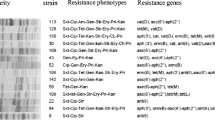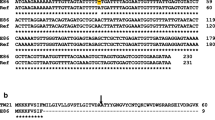Abstract
The presence of bacteriocin structural genes (entA, entB, entP, entQ, entAS-48, entL50A/B, bac31, and cylL) encoding different bacteriocins (enterocin A, enterocin B, enterocin P, enterocin Q, enterocin AS-48, enterocin L50A/B, bacteriocin 31 and cytolysin L, respectively), and the production of bacteriocin activity were analysed in 139 E. faecalis and 41 E. faecium clinical isolates of Tunisia. Forty-eight of 139 E. faecalis isolates (34%) and 7 of 41 of E. faecium isolates (17%) were bacteriocin producers. Sixty-two per cent of the bacteriocin-producing enterococci showed inhibitory activity against L. monocytogenes. Different combinations of entA, entB, entP, and entL50A/B genes were detected among the seven bacteriocin-producer E. faecium isolates, and more that one gene were identified in all the isolates. The entA gene was associated in most of the cases with entB gene in E. faecium isolates. Cyl LS were the unique genes detected among E. faecalis (in 24 of 48 bacteriocin-producer isolates, 50%). A β-hemolytic activity was demonstrated in 19 of the 24 cyl LS -positive E. faecalis isolates (79%), this activity being negative in the remaining five isolates. The presence of different bacteriocin structural genes and the production of antimicrobial activities seems to be a common trait of clinical enterococci.
Similar content being viewed by others
References
Aymerich T, Holo H, Havarstein LS et al (1996) Biochemical and genetic characterization of enterocin A from Enterococcus faecium, a new antilisterial bacteriocin in the pediocin family of bacteriocins. Appl Environ Microbiol 62:1676–1682
Balla E, Dicks MT, Du Toit M et al (2000) Characterization and cloning of the genes encoding enterocin 1071A and 1071B, two antimicrobial peptides produced by Enterococcus faecalis BFE1071. Appl Environ Microbiol 66:1298–1304
Booth MC, Bogie CP, Sahl HG et al (1996) Structural analysis and proteolytic activation of Enterococcus faecalis cytolysin, a novel lantibiotic. Mol Microbiol 21:1175–1184
Casaus P, Nilsen T, Cintas LM et al (1997) Enterocin B, a new bacteriocin from Enterococcus faecium T136 which can act synergistically with enterocin A. Microbiol 143:2287–2294
Cintas LM, Casaus P, Havarstein LS et al (1997) Biochemical and genetic characterization of enterocin P, a novel sec-dependent bacteriocin from Enterococcus faecium P13 with a broad antimicrobial spectrum. Appl Environ Microbiol 63:4321–4330
Cintas LM, Casaus P, Herranz C et al (2000) Biochemical and genetic evidence that Enterococcus faecium L50 produces enterocins L50A and L50B, the sec-dependent enterocin P, and a novel bacteriocin secreted without an N-terminal extension termed enterocin Q. J Bacteriol 23:806–814
Cintas LM, Casaus P, Holo H et al (1998) Enterocins L50A and L50B, two novel bacteriocins from Enterococcus faecium L50, are related to staphylococcal hemolysins. J Bacteriol 180:1988–1994
Coburn P, Gilmore MS (2003) The Enterococcus faecalis cytolysin: a novel toxin active against eukaryotic and prokaryotic cells. Cell Microbiol 5:661–669
Coque TM, Patterson JE, Steckelberg JM et al (1995) Incidence of hemolysin, gelatinase, and aggregation substance among enterococci isolated from patients with endocarditis and other infections and from feces of hospitalized and community-based persons. J Infect Dis 171:1223–1229
De Vuyst L, Foulquie Moreno MR, Revets H (2003) Screening for enterocins and detection of hemolysin and vancomycin resistance in enterococci of different origins. Int J Food Microbiol 84:299–318
Del Campo R, Tenorio C, Jiménez-Díaz R et al (2001) Bacteriocin production in vancomycin-resistant and vancomycin-susceptible Enterococcus isolates of different origins. Antimicrob Agents Chemother 45:905–912
Dupont H, Montravers P, Mohler J et al (1998) Disparate findings on the role of virulence factors of E. faecalis in mouse and rat models of peritonitis. Infect Immun 66:22570–22575
Franz CM, Worobo RW, Quadri LE et al (1999) Atypical genetic locus associated with constitutive production of enterocin B by Enterococcus faecium BFE 900. Appl Environ Microbiol 65:2170–2178
Franz CM, Van Belkum MJ, Holzapfel WH et al (2007) Diversity of enterococcal bacteriocins and their grouping in a new classification scheme. FEMS Microbiol Rev 31:293–310
Galvéz A, Giménez-Gallego G, Maqueda M et al (1989) Purification and amino acid composition of peptide antibiotic AS-48 produced by Streptococcus (Enterococcus) faecalis subsp. liquefaciens S-48. Antimicrob Agents Chemother 33:437–441
Gilmore MS, Segarra RA, Booth MC et al (1994) Genetic structure of the Enterococcus faecalis plasmid pAD1-encoded cytolytic toxin system and its relationship to lantibiotic determinants. J Bacteriol 176:7335–7344
Huycke M, Gilmore S (1995) Frequency of aggregation substance and cytolysin genes among enterococcal endocarditis isolates. Plasmid 34:152–156
Huycke M, Spiegel A, Gilmore MS (1991) Bacterimia caused by hemolytic, high-level gentamicin-resistant Enterococcus faecalis. Antimicrob Agents Chemother 35:1626–1637
Ike Y, Hashimoto H, Clewell DB (1984) Hemolysin of Streptococcus faecalis subspecies zymogenes contributes to virulence in mice. Infect Immun 45:528–530
Jett BD, Jensen HG, Nordquist RE et al (1992) Contribution of the pAD1-encoded cytolysin to the severity of experimental Enterococcus faecalis endophthalmitis. Infect Immun 60:2445–2452
Joosten HM, Rodriguez E, Nunez M (1997) PCR detection of sequences similar to the AS-48 structural gene in bacteriocin-producing enterococci. Lett Appl Microbiol 24:40–42
Klibi N, Gharbi S Masmoudi A et al (2006) Antibiotic resistance and mechanisms implicated in clinical enterococci in a Tunisian Hospital. J Chemother 18:20–26
Maqueda M, Galvez A, Martinez-Bueno M et al (1998) Widespread production of AS-48-like bacteriocins in strains of Enterococcus faecalis? Mol Microbiol 29:1318–1319
Murray BE (1990) The life and times of Enterococcus. Clin Microbiol Rev 3:46–65
Murray BE (1998) Diversity among multidrug-resistant enterococci. Emerg Infect Dis 4:37–47
Nes IF, Diep DB, Holo H (2007) Bacteriocin diversityy in Streptococcus and Enterococcus. J Bacteriol 189:1189–1198
Nilsen T, Nes IF, Holo H (2003) Enterolysin A, a cell wall-degrading bacteriocin from Enterococcus faecalis LMG 2333. Appl Environ Microbiol 69:2975–2984
Park SH, Itoh K, Fujisawa T (2003) Characteristics and identification of enterocins produced by Enterococcus faecium JCM 5804. J Applied Microbiol 95:294–300
Poeta P, Costa D, Rojo-Bezares B et al (2007) Detection of antimicrobial activities and bacteriocin structural genes faecal enterococci of wild animals. Microbiol Res 162:257–263
Semedo T, Santos MA, Martins P et al (2003) Comparative study using type strains and clinical and food isolates to examine hemolytic activity and occurrence of the cyl operon in enterococci. J Clin Microbiol 41:2569–2576
Sørum H, Sunde M (2001) Resistance to antibiotics in the normal flora of animals. Vet Res 32:227–241
Tannock GW (1995) Normal microflora. An introduction to microbes inhabiting the human body. Chapman and Hall, London
Tomita H, Fujimoto S, Tanimoto K et al (1997) Cloning and genetic and sequence analyses of the bacteriocin 31 determinant encoded on the Enterococcus faecalis pheromone-responsive conjugative plasmid pPD1. J Bacteriol 179:7843–7855
Vincent GHE, Lars A, Dzun BD et al (2002) Production of class II bacteriocins by lactic acid bacteria; an example of biological warfare and communication. Antonie Van Leeuwenhoek 81:639–654
Acknowledgements
This study has been possible thanks to a research project financed by the Spanish Agency of International Collaboration (AECI), from the Ministerio de Asuntos Exteriores of Spain and from the Tunisian Ministry of Research.
Author information
Authors and Affiliations
Corresponding author
Rights and permissions
About this article
Cite this article
Klibi, N., Jouini, A., Rojo-Bezares, B. et al. Phenotypic and genotypic characterization of bacteriocins in clinical enterococcal isolates of Tunisia. World J Microbiol Biotechnol 24, 653–657 (2008). https://doi.org/10.1007/s11274-007-9519-z
Received:
Accepted:
Published:
Issue Date:
DOI: https://doi.org/10.1007/s11274-007-9519-z




